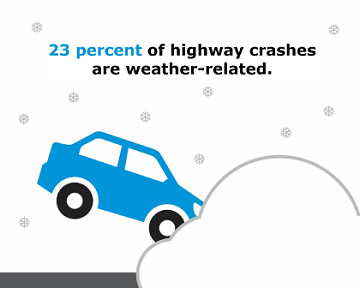- Home
- Loss Control
- Loss Control Insights
- How to Prepare for Winter Driving
Jim Janak, Risk Improvement Supervisor, Charlotte Branch
Having spent a large portion of my career on the road in New England and Pennsylvania, I know all about the hazards of winter driving. According to the Federal Highway Administration, 23-percent of highway crashes are weather-related. Although it’s easy to blame the weather, failing to properly maintain vehicles for cold weather driving also contributes to this statistic.
Based on my experience as a loss control professional and some tips from the National Highway Traffic Safety Administration, fleet managers and drivers should follow these five suggestions to prepare their vehicles for winter driving.
Check Your Tires Now and Throughout the Season
Tires have one primary function—to keep you on the road. Keeping tires properly inflated and in good condition will help prevent accidents. Check for uneven or insufficient tread. Tread should be at least one-sixth of an inch or greater. Remember, tire pressure drops when they are not driven during the winter. Encourage drivers to keep a tire pressure gauge in their vehicles at all times.
Schedule a Tune-Up
A simple fix could help drivers avoid becoming stranded this winter. A preseason tune-up can identify any problems with the vehicle’s battery, brakes, cooling system, lights, hoses and belts. If a problem is detected, now is the time to replace or repair parts.
Resolve Visibility Issues
Poor visibility leads to accidents, so make sure windshield wipers work and replace worn wipers if necessary. If you are driving in snowy regions, replace standard wipers with heavy-duty winter wipers. Also check to make sure the front and rear defrosters are working and remember to stock up on windshield wiper fluid.
Don’t Let Floor Mats Trip You Up
Incorrectly or improperly installed floor mats may interfere with the pedal operation. Be sure to follow the manufacturer’s instructions when installing floor mats. Clean the snow and ice from mats often, and verify that the mats have been reinstalled correctly after cleaning.
Talk Winter Driver Safety
Get your drivers together for a safety meeting. Share EMC’s Winter Driving Tech Sheet with your staff, remind them about completing a driver vehicle inspection report after each trip and discuss how best to respond to emergency situations.
You can’t control the weather, but with proper maintenance and driver training, you can control how your vehicles perform. Count of EMC® to help you with a full array of fleet safety resources.Get in touch
Need help? We’re here for you! Whether you have questions or need personalized assistance, your local office is ready to support you.
Loss Control Insights
Stay informed with the latest news and receive actionable safety tips, all carefully curated by our team of experts.
